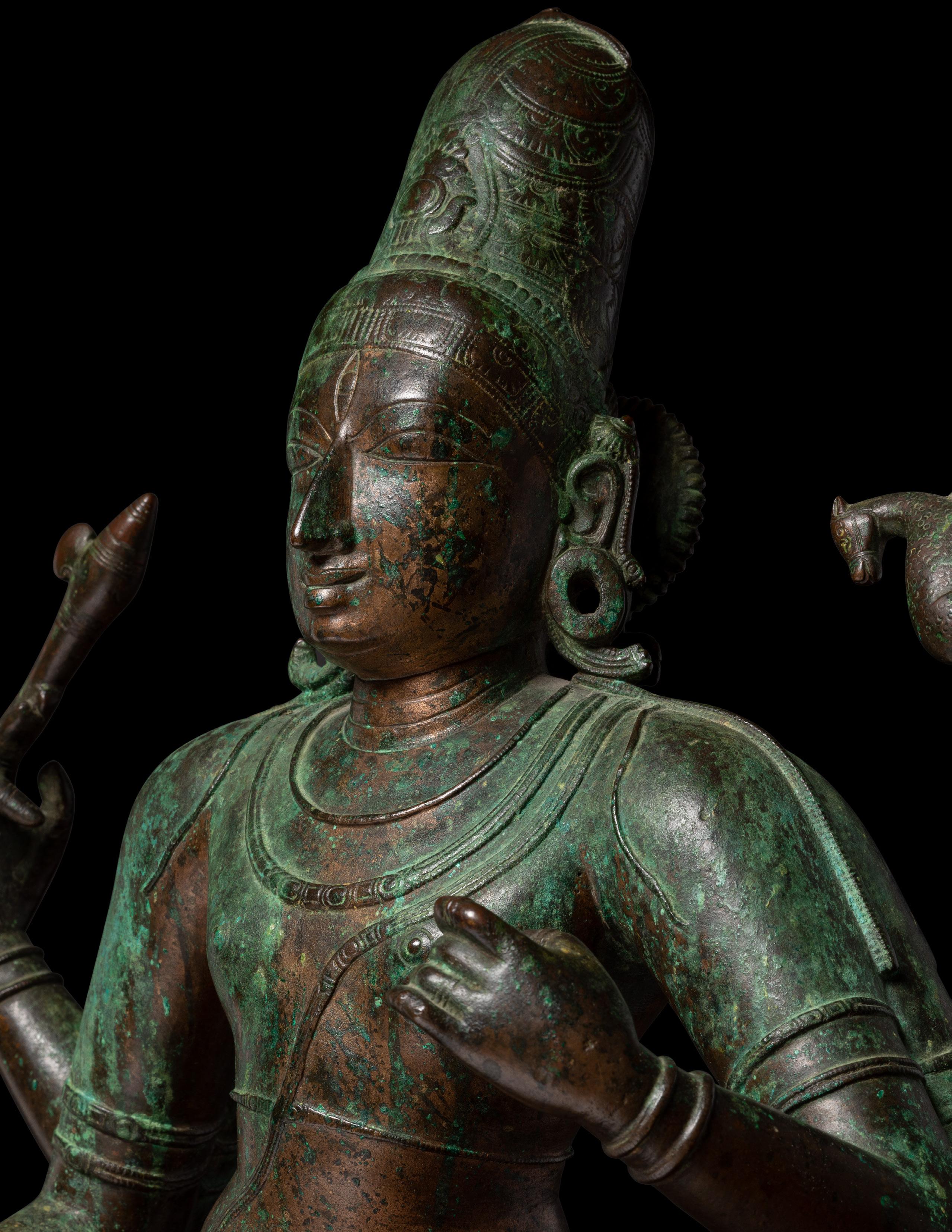
3 minute read
Shiva Vinadhara
Southern India, Tamil Nadu
Late Chola period, 13th-14th century
Copper alloy
32 1/4 in. (82 cm.) high
Provenance:
J.R. Pons Collection, Spain, by the 1970s.
Private American collection, acquired from the above in 1995.
Shiva stands here in a fluid tribhanga, donning a short veshti secured with a multi-banded belt punctuated at the center with a modest kirtimukha or ‘face of glory.’ Shiva’s face is perfectly symmetrical and equally composed in countenance as it is in modeling, conveying his transcendent power in a less explicit manner than his clearly defined third eye. He holds a battle ax (parasu) and a leaping antelope (mriga) in his upper hands symbolizing his dominance over nature. His primary hands project gracefully forward to the position where they once held his characteristic vina, a long-necked and pear-shaped lute.
According to Hindu practice, music has the power to lead one to moksha (liberation) and the present manifestation of the god Shiva embodies that notion. In his collection of poems known as Thiruvilayadal Puranam the Shaivite saint, Appar, describes an instance in which Shiva appears in the form of a woodcutter and plays the vina for one of his disciples. Therein he describes the vina as particularly lively and spirited among instruments for the ease with which it can be played without interruption.
While this manifestation of the god Shiva is described as ‘player of the vina,’ it is worthwhile to note that there is no known sculptural example including the actual instrument This element likely would have been separately cast and, thus, its loss is consistent with the figure’s age. The energy of the music Shiva represents is, instead, conveyed through the tips of Shiva’s fingers, which are modeled in position to steer the absent instrument’s strings, and in the naturalistic sway of his hips.
This striking bronze sculpture would have been commissioned for a temple shrine, but fitted for public procession for all to experience darshan—a sighting of the divine, which can have a tangible impact on one’s life. The practice of creating processional bronze figures like the present began in South India in the Pallava period (75-897 CE) and continued through the Chola (848-1279) and Vijayanagara periods (1336-1646). The present figure’s circular lotus base supported by a multitiered square plinth became common among Chola period bronzes. The lugs along the base allow for the insertion of poles used to carry the image during festival processions. These practical fixtures are also present in Vijayanagara examples.

The present Shiva’s hair is styled in a high jatamukuta (a pile of matted locks) sans protruding ornaments (such as a crescent moon and serpent) although decoratively elaborate. While this hairstyle appears to be a simplified expression of earlier Chola-period hairstyles with deeply defined locks and three-dimensional ornaments, a thirteenth-century bronze figure of Shiva in his manifestation as ‘The Lord Who Walked With Swaying Gait’ (Vattanaigal Padanadanda Nayakar) based on a poem by Appar from the twelfth century (Kulottunga I era), which resides within the well-known Valampuram temple of Nagapattinam, demonstrates that this style was born by the late Chola period. The undeniable likeness of the figures’ narrow faces with a sharp nose and full lips suggests that the present figure may have even been modeled on the twelfth-century Valampuram Shiva. The present Shiva’s robust thighs, lifted buttocks, and graceful tribhanga are a testament to this possibility, as limbs seem to become increasingly less naturalistic in later Vijayanagara artworks. Similarly robust thighs and nearly identical understated jewelry displayed by the present bronze, however, very closely match that of a Vijayanagara example of Shiva Chandrashekhara, which was once part of the renowned Pan-Asian collection; sold at Christie’s New York, 17 March 2015, lot 34.
As such, it is safe to date the present figure to the late Chola or transitional period—a period when artists remained committed to reproducing the elegance and lifelike appearance of Hindu bronze deities that Chola artists are lauded for. The present bronze figure of Shiva is sensuous and supple, retaining the gravitas of the era.









